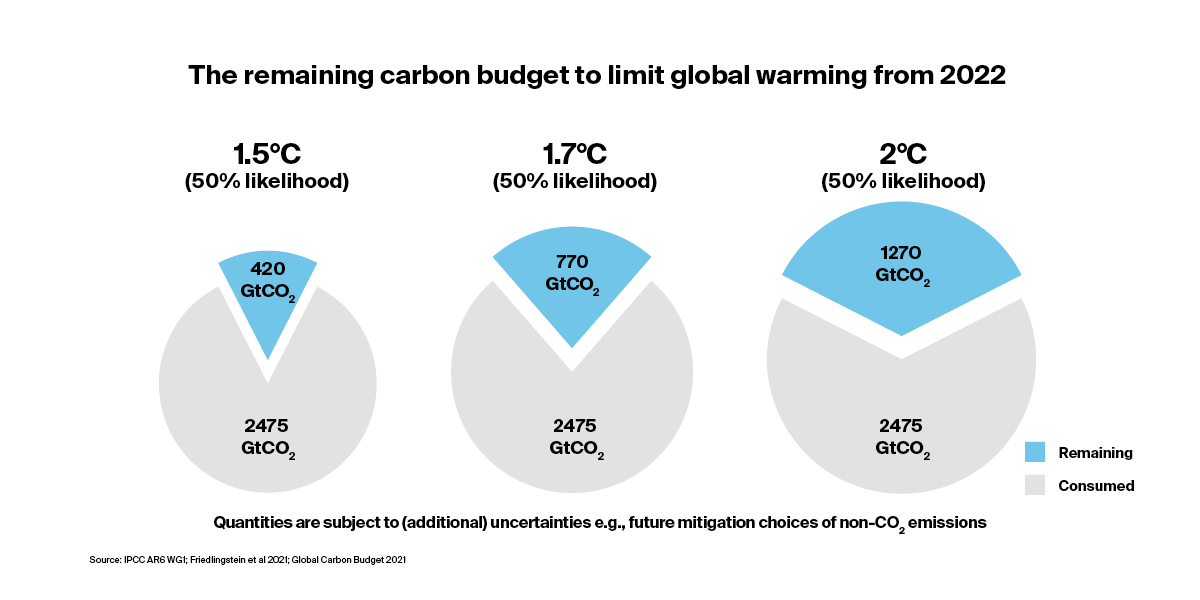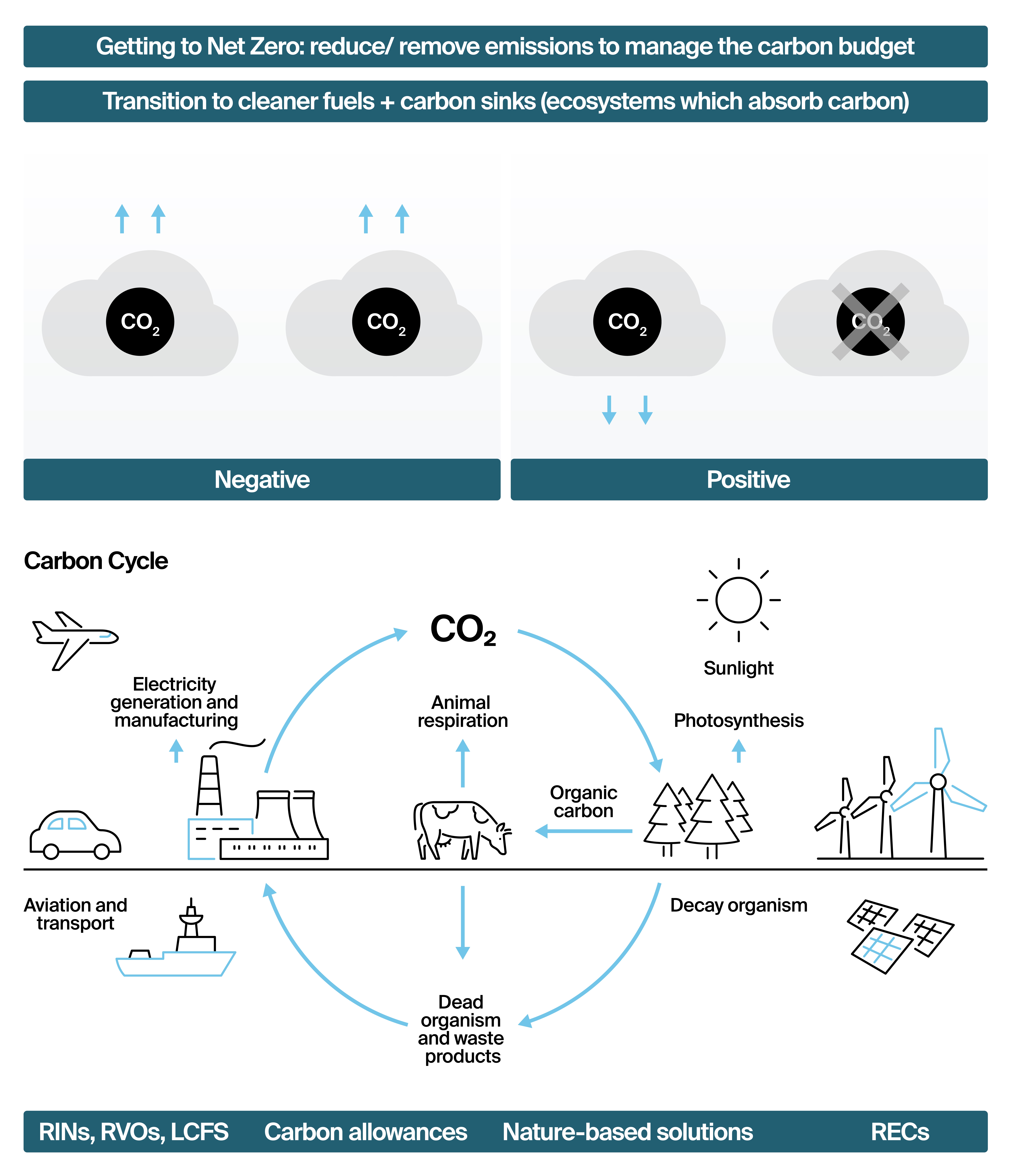
Environmental Markets: why they’re needed and how they work
Published
May 2022
Author

Reaching net zero carbon emissions in the coming decades will be critical if we are to limit the impact of climate change on our way of life. It will involve the transition to cleaner energy sources and the development of an asset class to reflect the value of natural ecosystems. This will require transformation across the global economy and progress is well underway.
To address climate change, it is critical to understand the carbon cycle. In simple terms, this is a process that sees plants use sunlight to take in carbon dioxide and emit oxygen. Those plants are eaten by animals, which convert plants to energy and exhale carbon dioxide. Over millions of years, this ‘loop’ helped sustain life and regulate the Earth’s temperature. Humans have disrupted this balance by releasing huge quantities of carbon and greenhouse gases into the atmosphere by burning fossil fuels and disrupting ecosystems for agricultural and other purposes.
Now, limiting global warming depends on our ability to balance the carbon budget, an estimate of the maximum greenhouse gases that can be emitted if global warming is to be kept to 1.5 degrees Celsius by 2050. This target has been determined by a United Nations body for assessing climate change science - the Intergovernmental Panel on Climate Change.
Here, environmental markets offer the opportunity to solve for a finite carbon budget in the most cost-effective manner. They do this by offering mechanisms for companies and policymakers to quantify, manage and value the environmental impact of their activities.

Measuring the impact
Limiting global warming requires the ability to value “externalities” - such as placing a price on pollution, carbon-free electricity and carbon sequestration and storage.
A negative externality exists when a production process has a harmful effect on unrelated third parties - such as carbon emissions causing global warming, with negative impacts for wildlife, the environment and people’s health.
Carbon allowances are the best example of an instrument which puts a value on a negative externality. These allowances are issued by a government under an emissions cap-and-trade program and are a revenue generator for governments through the auctioning process. Importantly, carbon cap and trade is the only way to control the quantity of emissions in the atmosphere. A carbon price is then determined by allowing the buying and selling of allowances between counterparties.
A positive externality has a beneficial effect for unrelated third parties. Examples include energy-efficiency improvements like increasing building insulation to reduce heat loss, or projects which restore land, like tree-planting in forests. Another example might be a wind or solar farm, where renewable energy is hitting the grid and potentially displacing a fossil fuel generator. By not contributing to our finite atmospheric carbon budget, renewable energy generates a ‘positive externality’ of avoided environmental costs.
To demonstrate compliance with specific renewable energy policies, Environmental Attribute Certificates can be used. These come in various forms around the world, such as a guarantee of origin (GOO) which gives electricity customers information on the source of their energy. These instruments can be traded and help to demonstrate compliance with a European Union directive which mandates specific levels of renewable energy use. Similarly in the U.S., renewable energy certificates (‘REC’) are used. A REC is created for every megawatt hour of electricity delivered to the grid from a renewable energy resource. As a tradeable market-based instrument, a REC can be used to lower a company’s gross carbon emissions from purchased electricity. While some entities are mandated to acquire RECs - such as under a USA State Renewable Portfolio Standard - others would do so voluntarily.
Placing a value on nature
To balance the carbon budget, it is vital to place a value on taking carbon out of the atmosphere and incentivise investment in assets which enable this process. Nature, through the process of photosynthesis, is critical to this part of the carbon cycle.
Nature-based carbon credits provide a price signal for the positive externality of carbon sequestration and storage. This helps to change behaviour, by attributing a value to the conservation and growth of nature rather than its extraction. Here, the value of a tree is more fully reflected - rather than just being about its conversion to timber.
Placing a price on nature’s ability to sequester and store carbon is only half of the equation. Natural capital refers to the ecosystems which include wetlands, rivers, lakes, forests, dunes and soils to sustain life on Earth. Unlike manufactured capital (goods or fixed assets which contribute to production process) and human capital (people's knowledge and skills) there are no established methods for valuing natural capital or economic incentives to help sustain it.
This could also come in the form of an equity instrument by holding stock in a Natural Asset Company (NAC). NACs would hold the rights to ecosystem services produced by natural, working, or hybrid lands. Given the huge variety in natural capital, which is a heterogenous asset class, an equity could be the key instrument to capture its value.
As the market for natural capital develops, nature-based carbon credits and NACs could allow companies and countries to offset their environmental liabilities.

A new economic model
The green premium - the additional cost for some clean energy sources - illustrates how much it will cost to reduce emissions across the economy where fossil fuels are involved. This includes the production of electricity, manufacturing, agriculture, transportation, and heating and cooling.
Wind and solar is now cost competitive with fossil fuels due to the learning rate of renewable technology. Policy support in the form of subsidies has also enabled the deployment of renewable technology.
Critically, the development of Carbonomics has also accelerated the erosion of the green premium in electricity generation by introducing instruments such as carbon allowances. These allow a cost to be attributed to the negative externality of pollution, while RECs can price the positive externality of carbon-free electricity.
Other technologies remain more expensive – such as green hydrogen and carbon removals. Their green premium must also be eroded to complete the energy transition and contribute to the goal of net zero.
Quoted markets, like ICE provide a venue for buyers and sellers to negotiate and hedge exposure to future price risk for a range of externalities, along with renewable fuels. A price signal for pollution, through a carbon allowance, can incentivise fuel switching from coal to natural gas and promote innovation in new, cleaner, technologies. Similarly, the development of natural capital as an asset class will help promote investment in life-sustaining ecosystems.
Reflecting how companies use environmental markets to manage and price climate risk, a record 18 billion tons of carbon allowances traded on ICE’s markets last year. This is equivalent to ~$1 trillion in notional value and equal to over half the world’s estimated total annual energy-related emissions footprint.
This illustrates one of many ways that markets facilitate efficient capital allocation across the carbon cycle, and ultimately, help to address the challenge of climate change.
Learn more about environmental markets
Related Content
The information contained in this paper - including text, graphics, links or other items - are provided "as is" and "as available." Intercontinental Exchange, Inc. its subsidiaries and affiliates (“ICE”) and third party providers do not warrant the accuracy, adequacy, timeliness, or completeness of this information, and expressly disclaims liability for errors, omissions or other defects, or delays or interruptions in this information. ICE does not verify any data and disclaims any obligation to do so. The information provided in this paper is also liable to change at short notice. You should not rely on any information contained in this paper without first checking with us that it is correct and up to date.
No warranty of any kind, implied, express or statutory, is given in conjunction with the information. The reliance on any information contained in this paper is done at your own risk and discretion and you alone will be responsible for any damage or loss to you, including but not limited to loss of data or loss or damage to any property or loss of data or loss of revenue that results from the use and reliance on such information.
In no event will ICE or its third party providers be liable for any damages, including without limitation direct or indirect, special, incidental, punitive, or consequential damages, losses or expenses arising out of or relating to your use of this information. Past performance is no guarantee of future results.
The content provided in this paper is not to be construed as a recommendation or offer to buy or sell or the solicitation of an offer to buy or sell any security, financial product or instrument, or to participate in any particular trading strategy. ICE does not make any recommendations regarding the merit of any company, security or other financial product or investment identified in this paper, nor does it make any recommendation regarding the purchase or sale of any such company, security, financial product or investment that may be described or referred to in this paper, nor endorse or sponsor any company identified in this paper. Prior to the execution of a purchase or sale of any security or investment, you are advised to consult with your banker, financial advisor or other relevant professionals (e.g. legal, tax and/or accounting counsel). Neither ICE nor its third party providers shall be liable for any investment decisions based upon or results obtained from the content provided in this paper. Nothing contained on this paper is intended to be, nor shall it be construed to be, legal, tax, accounting or investment advice.